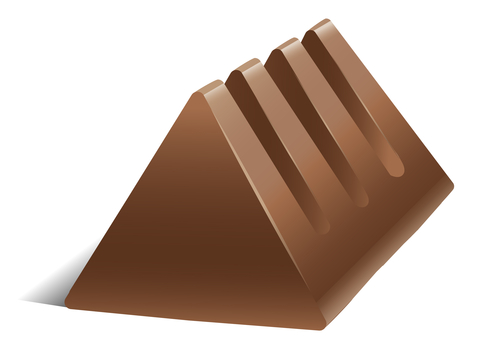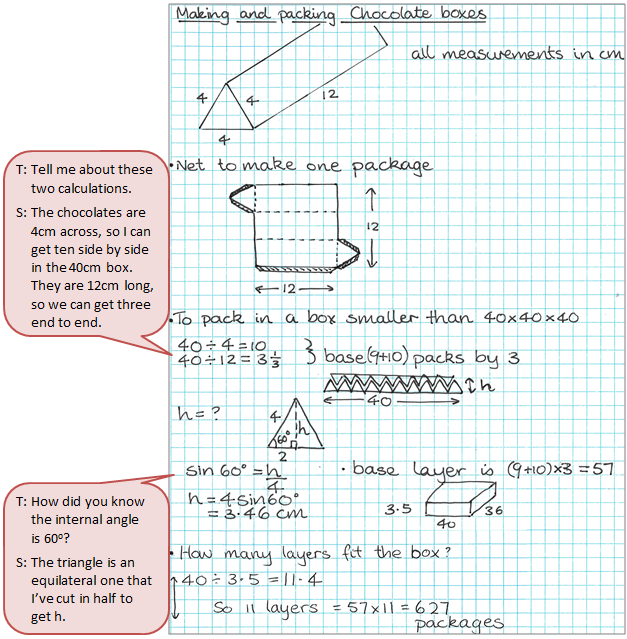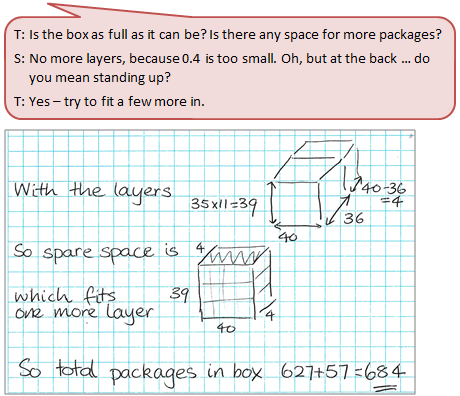The purpose of this activity is to engage students in applying their knowledge of three dimensional solids to solve a package and packing problem.
Thisactivity assumes the students have experience in the following areas:
- Find areas of triangles
- Find volumes of triangular prisms
- Work with metric units for length, area, and volume
- Create nets for solids.
The problem is sufficiently open ended to allow the students freedom of choice in their approach. It may be scaffolded with guidance that leads to a solution, and/or the students might be given the opportunity to solve the problem independently.
The example responses at the end of the resource give an indication of the kind of response to expect from students who approach the problem in particular ways.

Task: A chocolate manufacture produces bars shaped in a triangular prism of length 12 cm. The cross section of the bars is an equilateral triangle of side length 4 cm.
- Design a net for the packaging of the individual bars.
- The packaged bars are to be put into boxes that are 40 x 40 x 40 cm3. Find the maximum number of bars that can be packed into each box.
The following prompts illustrate how this activity can be structured around the phases of the Mathematics Investigation Cycle.
Make sense
Introduce the problem. Allow students time to read it and discuss in pairs or small groups.
- Can I draw or sketch the situation? (Drawing the triangular prism and cube box may be useful.)
- What information has been given?
- Is there anything missing?
- Is there an order to solving the problem?
- What do I need to find out?
Plan approach
Discuss ideas about how to solve the problem. Emphasise that, in the planning phase, you want students to say how they would solve the problem, not to actually solve it.
- What are the maths skills I need to work this out? (Finding volume of a triangular prism and cuboid will be needed. Creating nets for prisms is also needed.)
- How could I show this problem using numbers, pictures, graphs, tables, or materials? (Physically making the triangular prism will be helpful.)
- Which of these strategies should I pursue?
- What tools (digital or physical) could help my investigation?
Take action
Allow students time to work through their strategy and find a solution to the problem.
- Have I shown my workings in a step-by-step way?
- Does my answer seem correct? Is it close to my estimation?
- How could I make sure that I haven’t missed anything? (Particularly, is there another way to pack the packets into the box?)
- How do my results look different to others? Why could this be?
- Does my solution answer the question?
- Is there another possible answer or way to solve it?
Convince yourself and others
Allow students time to check their answers and then either have them pair share with other groups or ask for volunteers to share their solution with the class.
- What is the solution?
- Show and explain how you worked out your solution.
- Can others see how I worked it out?
- Which representation (text, table, graph, numbers, diagram, equations) will be easy to understand?
- Which ideas would convince others that my findings answer the investigation question?
Examples of work
Work sample 1
The student produces a net that meets the specifications given. The student follows instructions to solve a packing problem involving volumes that need to be calculated.
Click on the image to enlarge it. Click again to close. 
Work sample 2
The student produces a net that meets the specifications given. The student solves a packing problem involving volumes that need to be calculated.

